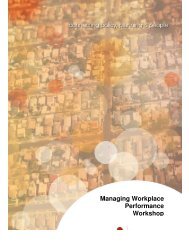Teenage Pregnancy Research Report - 3p Consulting
Teenage Pregnancy Research Report - 3p Consulting
Teenage Pregnancy Research Report - 3p Consulting
Create successful ePaper yourself
Turn your PDF publications into a flip-book with our unique Google optimized e-Paper software.
Reflecting the international data that links disadvantage with higher rates of teenage birth rates, those states withlarger proportions of rural and remote areas, significantly low socio-economic status and high population of indigenouspeople have higher rates than those that don’t. Therefore, in 2010 Victoria and the Australian Capital Territory recordedthe lowest teenage fertility rates in Australia (both at 9 births per 1,000), while the Northern Territory recorded thehighest (48 per 1,000).A young Aboriginal or Torres Strait Islander is six times more likely to be a teenage mother, with figures of 79 births per1000, than their non-indigenous counterpart. These figures mean that 21% of all indigenous mothers are teenagersas compared to 3% for non-indigenous mothers. Similarly, analysis of teenage birth rates between Sydney suburbsshows that affluent suburbs have teenage birth rates at 5.4 per 1000 compared to poorer suburbs with figures suchas 23.2 and 48 per 1000. It is suggested that teenagers in more affluent suburbs with better education and careerprospects are better informed and motivated to use contraception and abortion while women in lower socio-economicgroups are less likely to have the required knowledge and resources to access contraception or abortion services.In Australia, the majority of teenage births are to women aged 18 and 19 years (28% and 44% respectively). In 2010,the fertility rates for women aged 18 and 19 years were 21 per 1,000 and 33 per 1,000, respectively. In comparison,4% of births to teenage mothers were to women aged 15 years or younger.TasmaniaAs shown by Table 1, in 2010 Tasmania had the third highest rate of teenage fertility in Australia at 21.5 per 1,000following the Northern Territory and Queensland. This translates into 357 births across the state in 2010, a drop from443 births in 2009.The distribution of teenage fertility rates is uneven across the state with significantly high rates in each of the localgovernment areas that correspond to areas identified as high need, that is, those areas that have few social andeconomic resources available to households and that contend with socio-economic disadvantage.Table 2: <strong>Teenage</strong> Fertility Rate x Disadvantage (2005–2010)Socio-Economic Disadvantage Quintiles (excluding Burnie LGA)TasmaniaMost Disadvantaged 53.9 (±2.7)36.8 (±2.3)20.0 (±2)15.3 (±1.8)Least Disadvantaged 8.8 (±0.9)Source: Tasmanian Government, 2013, Kids Come First Update: Selected Outcomes for Children and Young Peoplein Tasmania, page 44The Tasmanian Kids Come First project, an initiative established by the Tasmanian Government in 2008 13 tracks andprovides wide-ranging data about Tasmanian children and young people data over time. The data is organised around30 outcome areas with 115 specific indicators. The outcomes framework compiles information down to suburb level,by age, gender and Aboriginal status. Kids Come First aims to make information readily available to policy makers,programs and services to assist in planning, managing and monitoring services.<strong>Teenage</strong> fertility rates are one of the specific indicators measured by the framework because while “many teenagebirths result in positive outcomes for both the mother and her child, teenage mothers are more likely to have poorerhealth, education and economic outcomes than older mothers”. 1422



